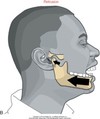Cervical, Vertebrae and TMJ Flashcards
name the craniovertebral ligaments
- posterior atlanto-occipital membrane
- posterior atlanto-axial membrane
- anterior atlanto-occipital membrane
- anterior atlanto-axial membrane
- tectorial membrane
- ligamentum nuchae
name the spinal ligaments
- ligamentum flavum
- anterior longitudinal ligament
- posterior longitudinal ligament
- supraspinous ligament
describe the structure of the atlanto-occipital articulation
convex occiptial condyles articulate with concave superior facets of the atlas
synovial plane joint
describe the structure of the atlanto-axial articulation
dens and anterior arch of atlas/transverse ligament - synovial pivot joint
inferior facets of the atlas with superior facets of the axis - biconvex with meniscoids
what is the role of the transverse ligament? What motion does it help limit?
prevents anterior displacement of C1 on C2
what is the role of the alar ligament? What motion does it help limit?
it becomes taut in neck flexion and during axial rotation
limits lateral flexion and prevents distraction of C1 on C2
What conditions can compromise the integrity of the transverse ligament? What does that result in? What are some possible dangers?
RA and Down’s syndrome
instability of C1/C2 joint
C1/C2 can slide and compress the spinal cord and even cause paralysis
describe the orientation of lower cervical facet joints
approximately 450 off frontal plane and transverse plane
maximizes motion
what osteokinematic motions occur at the cervical spine?
- Flexion/Extension
- Lateral flexion
- Rotation
- Protraction/Retraction
what produces protraction at the cervical vertebrae
combo of
lower C-spine flexion and upper C-spine extension
what produces retraction at the cervical vertebrae?
combo of
extension in lower C-spine and flexion in upper C-spine
what is the primary osteokinematic motion at the atlanto-occipital joint?
flexion/extension
describe the arthrokinematics at the atlanto-occipital joint?
convex (occipital condyle) on concave (superior facets of atlas)
opposite roll and glide/slide
T/F: movements in the transverse plane are limited at the atlanto-occipital joint?
TRUE
limited by deep joint congruency
Atlanto-occpital flexion = occipital condyle roll ______ and glide ________
Atlanto-occipital extension = occipital condyle roll _____ and glide _______
- anterior; posterior
- posterio; anterior
what is the primary osteokinematic motion that occurs at the atlanto-axial joint?
rotation
describe the arthrokinematics at the atlanto-axial joint
inferior facet of atlas/superior facet of axis
gliding → ipsilateral posterior glide with contralateral anterior glide

what limits rotation at the atlanto-axial joint?
alar ligaments
what limits movement in the sagittal plane at the atlanto-axial joint?
inferior facet of atlas/superior facet of axis → no gliding
limited by transverse ligament
atlanto-axial joint tilt instead
what limits tilting of the axis at the atlanto-axial joint with flexion?
transverse ligament
what coupling motion occur in the lower cervical spine?
lateral flexion with rotation coupled in the same direction
what would occur if either lateral flexion or rotation was done in isolation rather than in a coupling motion?
the facet joints would come into contact with one another blocking the motion
describe the arthrokinematics that occur during flexion/extension of C3-C7
flexion = inferior facet (of superior vertebrae) glides anterior and superior to superior facet (of inferior vertebrae)
extension = inferior facet (of superior vertebrae) slides posterior and inferior to superior facet (of inferior vertebrae)

describe the arthorkinematics that occur during rotation in C3-C7
same side as rotation = inferior facet glides posterior and slightly inferior
opposite side as rotation = inferior facet glides anterior and slightly superior












